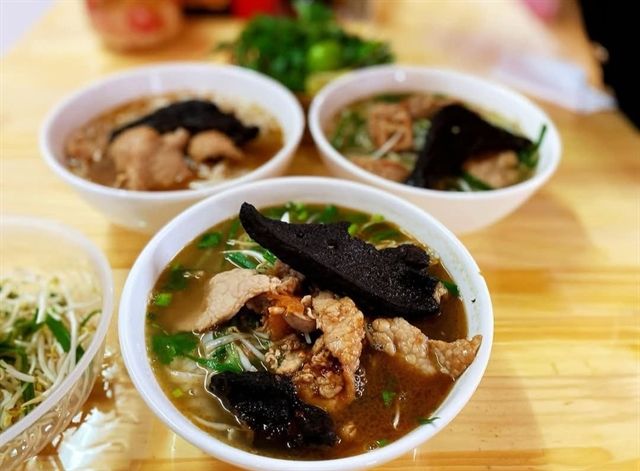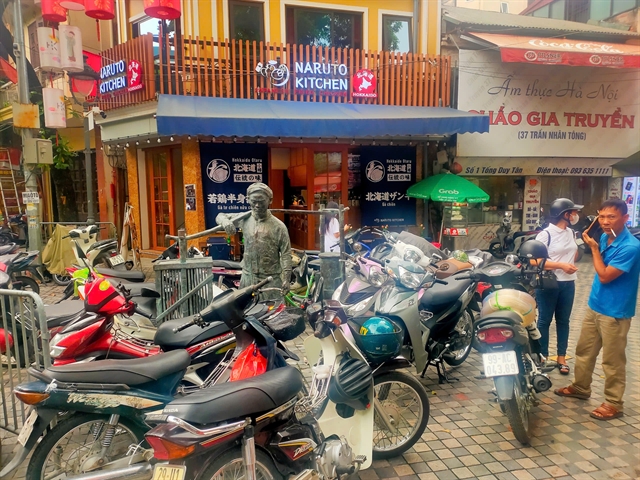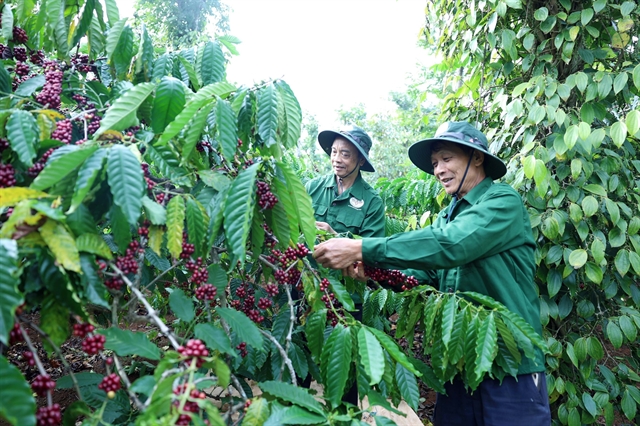 Life & Style
Life & Style

HÀ NỘI — A bronze statue depicting a traditional phở vendor from early 20th-century Hà Nội has been installed on Tống Duy Tân Food Street, aiming to honour the city’s signature dish. Yet despite its cultural significance, the artwork often goes unnoticed, blending into the busy surroundings.
Phở vendors carrying shoulder poles began appearing around 1907–1910, selling bowls of noodle soup from mobile set-ups. One end of the pole held a pot of broth, while the other carried ingredients and utensils. At the time, phở was a street food served across Hà Nội’s neighbourhoods.
 |
| The bronze statue depicting a traditional phở vendor from early 20th-century Hà Nội aims to honour the city’s signature dish. — VNS Photos Đoàn Tùng |
The statue, created by artist Nguyễn Thế Sơn and sculptor Trần Quốc Thịnh, stands 1.6 metres tall and was placed at the intersection of Tống Duy Tân and Trần Phú streets in December 2024. Its location is near the well-known Train Street café area, a frequent stop for both local and international visitors.
Cast in dark bronze and life-sized, the statue can be difficult to spot amid the crowds. Without deliberate attention, passersby may overlook it entirely.
The surrounding area is paved with small tiles, and spotlights illuminate the statue at night. However, the absence of a nameplate or protective fencing has led to nearby motorbike parking, which obstructs the view and diminishes the intended impact.
A local phở vendor commented: “Since the statue was installed, visitors have found a new photo spot along the food street. But it’s quite small, you have to look carefully to see it.”
“It reminds me of an old photo I saw in a magazine,” said Lê Tuyết Mai, a resident of Đống Đa. “Seeing it here brings back memories of harder times, when a bowl of phở was considered a luxury.”
Another resident, Võ Hoàng Anh suggested improvements, saying: “Authorities should set boundaries around the statue and add multilingual signage. A fence would help protect it – I’ve seen motorbikes parked right next to it.”
The statue is part of a broader initiative launched in 2018 by the former Hoàn Kiếm District People’s Committee. The project aims to develop Tống Duy Tân Street and Cấm Chỉ Alley into a regulated culinary zone that promotes food safety and respectful commerce.
Speaking to Dân Việt newspaper, Director of the District Investment Project Management Board Nguyễn Vũ Linh acknowledged the issue: “We’ve raised concerns with Cửa Nam Ward officials about maintaining urban order. A bronze plaque naming the artists will be added soon, along with a QR code for visitors to learn more about the history of phở gánh (noodle soup sold from kitchens on carrying poles).”
 |
| Cast in dark bronze, the statue blends so seamlessly into the bustling crowd that it often goes unnoticed without a discerning eye. |
Tống Duy Tân Street and Cấm Chỉ Alley (now Hàng Bông Alley) are among Hà Nội’s oldest neighbourhoods, established in 1873. Their proximity to the imperial examination hall once made them a hub for food vendors serving exam candidates.
Over the years, the street underwent several name changes, from Rue Brusseaux during the colonial era, to Bùi Bá Ký and later Kỳ Đồng Street, known for its famous steamed rice rolls. In 1964, it was renamed Tống Duy Tân Street in honour of the 19th-century patriot and scholar.
In 2000, the city approved infrastructure upgrades to transform the area into a cultural and culinary destination. Tống Duy Tân Street stretches 200 metres and is about eight metres wide, while Hàng Bông Alley spans 100 metres and is four metres across. Both streets now operate without sidewalks. The Vietnamese Culinary Culture Street officially opened in March 2002. — VNS




